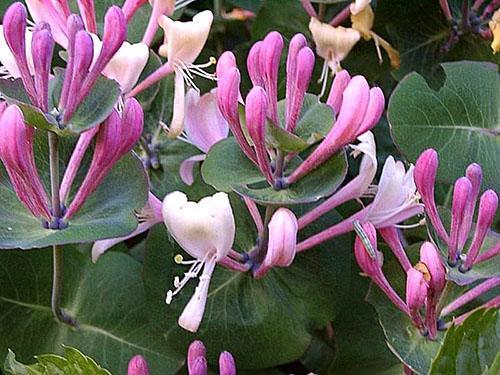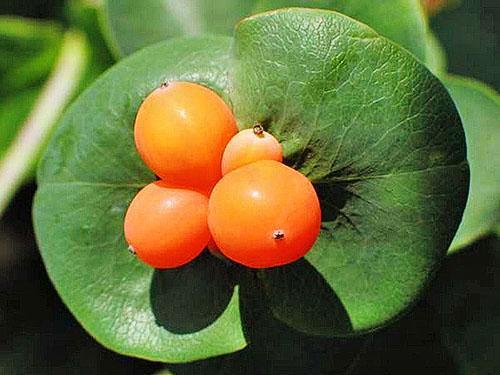Choose a fragrant vine, honeysuckle, honeysuckle for your garden
 Among the ornamental shrubs, honeysuckle, honeysuckle, aromatic liana draws special attention. A rapidly growing vine can decorate high fenceseparating the site from the road. With the arrangement of guide supports, the plant can rush up to 4-5 meters. At the same time, the lash is strewn with large and fragrant inflorescences for a month.
Among the ornamental shrubs, honeysuckle, honeysuckle, aromatic liana draws special attention. A rapidly growing vine can decorate high fenceseparating the site from the road. With the arrangement of guide supports, the plant can rush up to 4-5 meters. At the same time, the lash is strewn with large and fragrant inflorescences for a month.
Basic information about the plant

It is possible to determine that we have honeysuckle honeysuckle by the following signs:
- shoots are light green, pink-red from the sun;
- leaves are collected in elliptical plates;
- flowers on long tubes are collected in a bunch;
- the aroma of flowers is spicy;
- orange berries are inedible.
A naked young shoot in search of support can use the skeletal branch of a bush, and then a sloppy green lump is formed. Therefore, it is so important to form a plant from the first days of its development. The leaves are very dense and elliptical. The pairs grow together into a disk, and a flower panicle develops in the middle of it.
 The flowers towering above the ellipse on tall tubes with protruding stamens and pistils give off a strong pleasant aroma. The flowers themselves are very unusual and decorative. During the period of abundant flowering, the decorative honeysuckle honeysuckle is an excellent honey plant. Flowering lasts about a month, as a result, inedible orange berries are tied.
The flowers towering above the ellipse on tall tubes with protruding stamens and pistils give off a strong pleasant aroma. The flowers themselves are very unusual and decorative. During the period of abundant flowering, the decorative honeysuckle honeysuckle is an excellent honey plant. Flowering lasts about a month, as a result, inedible orange berries are tied.
Currently, this species of lianas is not cultivated only in the northern regions with a sharply continental climate. The reason is that the southern plant freezes over the winter.
Agrotechnics of decorative curly honeysuckle
 To get a fast growing shoot with abundant flowering, it is necessary to create optimal conditions for the development of the bush. To do this, the vine must be planted in a sunny place with a low standing of groundwater. The soil should be light on the basis of humus, garden soddy soil and sand. The reaction should be neutral or slightly alkaline.
To get a fast growing shoot with abundant flowering, it is necessary to create optimal conditions for the development of the bush. To do this, the vine must be planted in a sunny place with a low standing of groundwater. The soil should be light on the basis of humus, garden soddy soil and sand. The reaction should be neutral or slightly alkaline.
Watering honeysuckle loves moderate, responds well to spring feeding with humus. During the summer, it will gratefully accept irrigation watering over greenery during a drought and 2-3 additional fertilizing with full mineral fertilizer or mullein infusion until mid-July, later it should not be fed, so as not to disturb winter hardiness. The soil under the bush should be loosened and mulched.
The decorative honeysuckle honeysuckle responds well to crown-forming pruning, which is carried out in the spring before the first living buds. Dry twigs should also be cut. A slightly flaking bark on an old vine is a generic sign.
 Diseases and pests of decorative honeysuckle honeysuckle destroy the beauty of the green fence, therefore, in order to prevent pests and diseases from entering your green fence, you must follow some rules that are applicable to other plants:
Diseases and pests of decorative honeysuckle honeysuckle destroy the beauty of the green fence, therefore, in order to prevent pests and diseases from entering your green fence, you must follow some rules that are applicable to other plants:
- The predominance of phosphorus and potassium in the diet makes the sap of the plant unattractive to aphids and other leaf-eating insects and larvae. To do this, scatter in the near-barrel circle superphosphate, ash, lime.
- Wintering pests can be destroyed if the bushes are sprayed with a 5% urea solution before leaf fall.
- Use for spraying biological products Bitoxibacillin, Lepocide and the like, bacteria from which invade insects and destroy from the inside.
Prevention is always better than combating pests that have proliferated.
Ornamental plants are attractive only when the crown is well formed and the leaves are not damaged by diseases and pests.
Breeding honeysuckle honeysuckle
Anyone who has seen how the honeysuckle grows will inevitably want to have this vine in his possession. Reproduction of honeysuckle honeysuckle is possible in several ways:
- seeds;
- layering;
- cuttings.
Honeysuckle can only be propagated with fresh seeds of the second year. The harvested fruits should be freed from the pulp, rinsed and dried. Seeds must be stratified before spring sowing. Seeds for seedlings are sown in spring, and in summer, grown seedlings are placed in a permanent place.
 Planting material for cuttings is harvested in August. Cuttings with three internodes are rooted in autumn in a special nursery with a sand-peat mixture. In the spring, the rooted plant is planted in a permanent place.
Planting material for cuttings is harvested in August. Cuttings with three internodes are rooted in autumn in a special nursery with a sand-peat mixture. In the spring, the rooted plant is planted in a permanent place.
 The easiest way is to propagate honeysuckle honeysuckle by rooting a layer, which is notched and buried in the ground on a liana that continues to grow. In the place of the incision, roots are formed, the twig is separated from the liana and planted in a permanent place.
The easiest way is to propagate honeysuckle honeysuckle by rooting a layer, which is notched and buried in the ground on a liana that continues to grow. In the place of the incision, roots are formed, the twig is separated from the liana and planted in a permanent place.
Honeysuckle honeysuckle does not tolerate multiple transplants. When the first roots appear, it is necessary to provide the plant with a permanent place of residence.
Planting and caring for curly honeysuckle
 In advance, at a place determined for the composition, single pits 60 cm deep or a trench are dug, which is filled with fertile soil with a large amount of compost or last year's manure. Be sure to apply mineral fertilizers. Do not forget about ash so that mineral fertilizers do not deoxidize the soil.
In advance, at a place determined for the composition, single pits 60 cm deep or a trench are dug, which is filled with fertile soil with a large amount of compost or last year's manure. Be sure to apply mineral fertilizers. Do not forget about ash so that mineral fertilizers do not deoxidize the soil.
The best time to plant and care for curly honeysuckle is April - May. In a year, the plant will rise 2 meters. But in the first two years, the vines need to be removed from the supports for the winter and protected from freezing. Throughout the entire growth period, the vine needs a caring pruning and crown formation.
Read also the article in the topic: honeysuckle - planting and care in the suburbs!
Hello. I bought honeysuckle honeysuckle by mail from a woman. I planted it, it took root well. But her leaves are not at all similar (in my opinion) to the leaves of climbing honeysuckle. They are rough and thin. Please look at the photo - is this honeysuckle honeysuckle or not?
I put her in the shade, because. I want to close an unsightly fence. Will it bloom in the shade? And do I need to somehow warm it up for the winter, because it is still small? If necessary, what is the best? Is it possible to mulch the roots with sawdust?
And I also read that the lower leaves on the climbing honeysuckle almost all fall off and so that bare branches without leaves do not spoil the front view, it is better to plant some low-growing plants. What can you advise, given that the honeysuckle is planted in the shade
This plant is really not very similar to a "pure" varietal honeysuckle. Perhaps this is one of her hybrids. As for planting, honeysuckle grows well in partial shade, but for active flowering (and fruiting) it needs a well-lit place.
Varietal honeysuckle rarely freezes, but its hybrids do not have such resistance and need shelter for the winter. The roots can be mulched with sawdust, in addition, the shoots will need to be removed from the support, laid on the ground and covered with dry leaves or spandbond.
So that the trunk of the honeysuckle is not exposed from below, it must be shaped.Usually, the first pruning is carried out immediately after planting, shortening the branches by 2/3. In the second year, no more than 4 strong branches are left, and the rest are cut out. Although my honeysuckle is only the second year, there has not yet been complete "baldness" in the lower part of the bush. If you wish, you can plant a tenacious bush near the bush - it is no higher than 15 cm and loves shade. Creeping plants (cuff, periwinkle, clefthoof) will also look good next to an adult and high honeysuckle.
Here is the whole plant